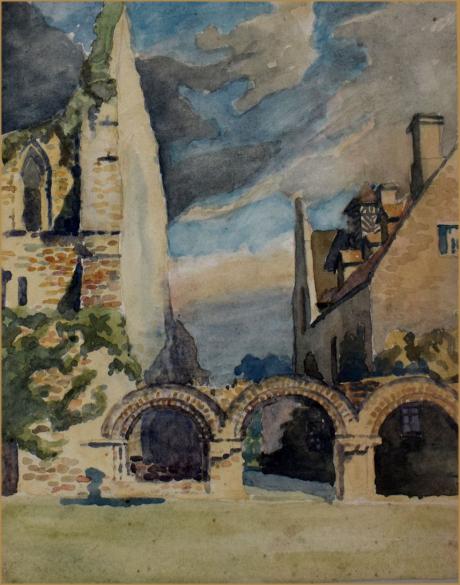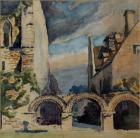inscribed and dated on the reverse " Part of South Transept / , Much Wenlock Abbey / Sept 1928"
Wenlock Priory, or St Milburga's Priory, is a ruined 12th century monastery, located in Much Wenlock, Shropshire, at grid reference SJ625001. The foundation was a part of the Cluniac order, which was refounded in 1079 and 1082, on the site of an earlier 7th century monastery, by Roger de Montgomery. It is thought to be the final resting place of Saint Milburga, whose bones were reputedly discovered during restoration work in 1101.
Parts of the building became a house later known as "Wenlock Abbey", which is privately owned, but most of Wenlock Priory is open to the public under the care of English Heritage and is used mostly for recreational purposes. The grounds have a collection of topiary. Merewalh, King of the Magonsaete founded the original Anglo-Saxon monastery here circa 680 and Merewalh's daughter quickly became its abbess, and was later canonised. After her death circa 727, however, little is historically known of the monastery until the Norman Conquest. It is known that the priory was inhabited by monks until after the Norman conquest. In the 12th century, the abbey was replaced by a Cluniac priory for men.
Just after 1200 Prior Humbert obtained various grants from King Henry III, an occasional guest at the Priory, who imported his own wines to be stored there. The grants enabled the building of a newer, larger church. Following the reformation of the monastery, in the early 14th century, the priory church was lavishly and completely rebuilt, and today considerable remains are left of the 350-foot-long church (110 m), including the north and south transept and the nave.
Around the Priory, the town of Much Wenlock was formed. The town is made up of a small network of intricate, narrow streets lined with timber-framed black and white buildings. Within the town is the well of St Milburga of Wenlock which was said to have cured sight impairments and helped Victorian women find a suitor. Following the dissolution in 1540, several buildings, including the late 15th-century Prior's House, were converted into a private residence later known as "Wenlock Abbey". In the 19th century it was purchased by James Milnes Gaskell MP for Wenlock, from his wife's cousin Sir Watkin Williams Wynn. It was restored and turned into a home by his son Charles Milnes Gaskell and his wife Lady Catherine, daughter of the Earl of Portsmouth, who entertained many eminent Victorians and Edwardians, including Thomas Hardy and Henry James. It remains inhabited, and is currently owned by Gabrielle Drake and her husband. It is not open to the public. The tranquil ruins of Wenlock Priory stand in a picturesque setting on the fringe of beautiful Much Wenlock. An Anglo-Saxon monastery was founded here in about 680 by King Merewalh of Mercia, whose abbess daughter Milburge was hailed as a saint. Her relics were miraculously re-discovered here in 1101, attracting both pilgrims and prosperity to the priory.
By then Wenlock had been re-founded by the Normans as a priory of Cluniac monks. It is the impressive remains of this medieval priory which survive today, everywhere reflecting the Cluniac love of elaborate decoration. Parts of the great 13th century church still stand high.
Much Wenlock is a small town and parish in Shropshire, England, situated on the A458 road between Shrewsbury and Bridgnorth. Nearby, to the northeast, is the Ironbridge Gorge, and the new town of Telford. The civil parish includes the villages of Homer (1 mile north of the town), Wyke (2 miles northeast), Atterley (2 miles southeast) and Bourton (3 miles southwest). The population of the civil parish, according to the 2001 census, was 2,605, increasing to 2,877 at the 2011 Census.
Much Wenlock was historically the chief town of the ancient borough of Wenlock. The "Much" was added to the name to distinguish it from the nearby Little Wenlock, and signifies that it is the larger of the two settlements. Notable historic attractions in the town are Wenlock Priory and the Guildhall. The name Wenlock probably comes from the Celtic name Wininicas, meaning "white area" (in reference to the limestone of Wenlock Edge), plus the Old English loca, meaning "enclosed place". The town was recorded in the Domesday Book as Wenloch.
The Wenlock Olympian Games established by Dr William Penny Brookes in 1850 are centred in the town. Dr Brookes is credited as a founding father of the modern Olympic Games, and one of the Olympic mascots for London 2012 was named Wenlock after the town.
Richard Fletcher mentions Much Wenlock as one of the possible locations where a Sub-Roman British Christian community may have survived the Anglo-Saxon occupation and eventually integrated with the conquerors and influenced their culture.
The town of Wenlock is known to have grown up around an abbey or monastery founded around 680 by Merewalh, a son of King Penda of Mercia, with the small town within its parish boundaries. King Penda installed his daughter Milburga as abbess in 687. Milburga of Wenlock was credited with many miraculous works. The abbey flourished until around 874 when it is thought that a Danish Viking attack occurred.
The Domesday Book of 1086 records the manor as 'Wenloch' and forming part of the hundred of Patton. It was already at this time a fairly large settlement, with 73 households. The abbey is also recorded in the book, separately. In the 11th century another religious house was built on the same site by Leofric, Earl of Mercia and Countess Godiva his wife. In the 12th century this was replaced by a Cluniac priory, established by Roger de Montgomerie after the Norman conquest, the ruins of which can still be seen and which is now in the hands of English Heritage.
Early in the 12th century the hundred of Patton was merged with Culvestan to form the hundred of Munslow, but in 1198 Much Wenlock, together with the other manors held by Wenlock Priory, was transferred to the hundredal jurisdiction of the Liberty of Wenlock (also known as Wenlock Franchise).
In 1468 Edward IV granted the men of Much Wenlock a charter forming the Borough of Wenlock, at the request of Sir John Wenlock, and "in consideration of the laudable services which the men of the town performed in assisting the king to gain possession of the crown." The charter was confirmed in 1547 by Henry VIII after Wenlock Priory was suppressed in the Dissolution of the Monasteries in 1539. The charter was again confirmed in 1631 by Charles I.
Over the years the borough asserted jurisdiction over the liberty of Wenlock. The lands of the liberty included rural areas and a number of detached parts well outside the town, and this resulted in an unusual, geographically dispersed borough.[9] At its height, it was – by area – the largest borough in England[10] outside London and encompassed several of the towns that now constitute Telford. The borough had unusual boundaries, covering Much Wenlock itself, but also Little Wenlock, Broseley and Ironbridge, a total area of 71 square miles (180 km2). In 1836 the borough was reformed as a municipal borough under the Municipal Corporations Act 1835, and lost some of its rural areas and detached parts. The borough was further reduced in size in 1889, and was finally abolished in 1966.
11-year-old Alice Glaston from Little Wenlock was hanged together with two men in Much Wenlock on 13 April 1546, for an unknown crime. She is the youngest known girl legally executed in Great Britain. Sir Thomas Wolryche, 1st Baronet (1598–1668) was an English landowner and politician who sat in the House of Commons for Wenlock between 1621 and 1625. He fought in the Royalist army in the English Civil War, serving as military governor of Bridgnorth. In 1611, Thomas Wolryche's father, Francis, had taken over the mortgage of the manor of Hughley, about 6 km from Much Wenlock. The debt was cleared in 1623 in return for the freehold of Hughley, an estate of 1,400 acres.
In the 19th century the town and much of the surrounding land came into the possession of James Milnes Gaskell, from his wife's family the Williams-Wynns. James was MP for Wenlock for many years. His son Charles Milnes Gaskell restored the Priory lodging as a home with his wife Lady Catherine, daughter of the Earl of Portsmouth. There they entertained many famous people of the day, writers, politicians, artists and explorers, among them Thomas Hardy, Henry Adams, Henry James, Thomas Woolner, Henry Morton Stanley, Isabella Bird and Phillip Webb.
Much Wenlock has become known as the birthplace of Wenlock Olympian Games set up by Dr William Penny Brookes and his Wenlock Olympian Society (WOS) in 1850. In 1861 he was also instrumental in setting up the Shropshire Games and later in 1866, the National Olympian Games. Dr Brookes is credited as a founding father of the Modern Olympic Games. In 1890 it was the turn of the Raven Hotel to be the venue for the annual post Wenlock Olympian Games' dinner, and Baron Pierre de Coubertin was the guest of honour. Copies of some of the WOS's archive images are on display in the hotel, including letters from Coubertin to Brookes. The Wenlock Olympian Games, a nine-day event staged on eight sites across Shropshire, are still held annually during July, and are still organised by WOS. Much Wenlock's secondary school is named after Dr Brookes.
The Olympic mascot for London 2012 was named Wenlock[15] to honour Dr Brookes, WOS and Much Wenlock. On 30 May 2012, the Olympic flame of the London 2012 Summer Games, was carried through Much Wenlock to acknowledge the founding footsteps of Dr Brookes. WOS Vice-President, John Simpson, carried an Olympic torch from the town into the William Brookes School. When the Borough was abolished in 1966 the core Wenlock parts became part of the Bridgnorth Rural District,[17] with other parts also going to Dawley Urban District and to Wellington Rural District. In 1974 Much Wenlock joined Bridgnorth District until it was abolished in 2009.
Much Wenlock was the first community in the West Midlands to have a neighbourhood development plan. The plan was put to a parish referendum on 22 May 2014. There was a 41.8% turnout, and 84.6% of those voting said "yes" to the referendum question: "Do you want Shropshire Council to use the Neighbourhood Plan for Much Wenlock to help it decide planning applications in the neighbourhood area." The Neighbourhood Plan was "made" (adopted) by Shropshire Council on 17 July 2014. Planning applications in the town and surrounding parish must be considered against the Neighbourhood Plan as well as existing planning policy where appropriate, such as the Shropshire-wide Core Strategy and as well as the National Planning Policy Framework.
Much Wenlock was the location for the third episode of the first series of the archaeology television programme Time Team in 1994.
Albert Vincent Reade was born in 1864, he was a portrait, landscape and still life painter. He studied at the Manchester Academy of Fine Arts and Colarossi's Paris, He exhibited between 1901 and 1933 and lived in Manchester.


